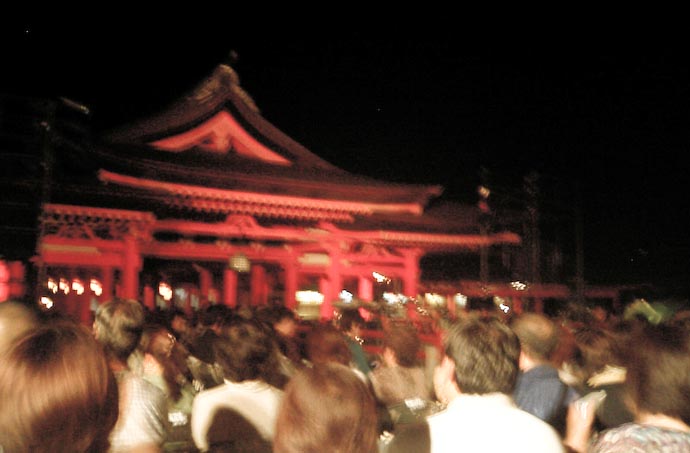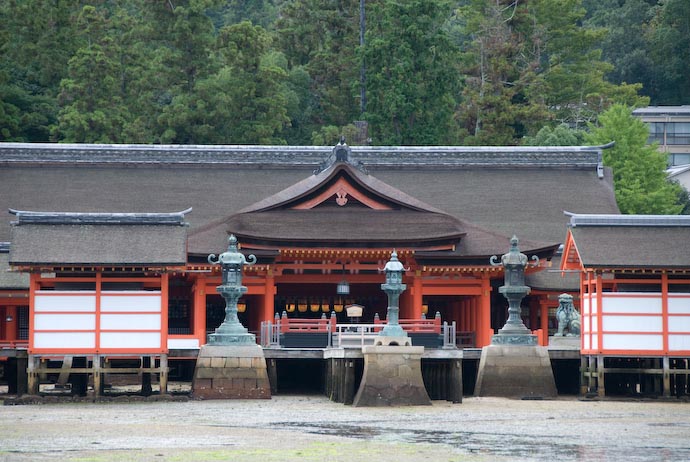
Nikon D200 + Nikkor 18-200mm f/3.5-5.6 VR @ 130mm — 1/180 sec, f/5.6, ISO 500 — map & image data — nearby photos
A small part of
Itsukushima Shrine (厳島神社、宮島), Miyajima Japan
during low tide
As I mentioned yesterday, we went to Miyajima on Sunday to see Kousuke Atari (中孝介) in concert at the Itsukushima Shrine (厳島神社), a large complex almost completely over the water when the tide is in. In the picture above, which I took the morning after the concert when the tide was out, you can see the piers and such.
The concert was in the open air away from the building, on a little dais you can sort of see in the center of the picture.
Photography was not permitted during the concert, so I didn't bring my camera, but before he took the “stage” (the dais was pretty small) I snapped a picture with my archaic cell phone....
We were the 6th row back; the stage is just in front of the people on the right.
It's been ages since I've seen a live music concert, much less a pop music one. The audience had people of all ages, from children to the elderly with walkers, split about evenly down gender lines. For what I could tell, I was the only person (out of about the 800 in attendance) who clearly looked “not Japanese.”
The singer, Kousuke Atari, is from a relatively small island way in the south of Japan (Amami Ooshima) with its own indigenous language and culture that was mostly stamped out during the earlier half of the previous century. Coincidentally, Fumie's grandmother is also from there, and apparently when she was a little girl, kids would be punished for speaking the local dialect.
Times are different now, and the area's uniqueness is embraced. Part of his draw is that before he became famous, he spent years studying the local singing style, and now incorporates that into his more mainstream music.
He has an interesting quality about his voice in that he sometimes sounds as if he's harmonizing with someone else. Listening to his CDs, I thought it was two people harmonizing until I saw him sing live a cappella. You can sort of get a feel for the effect in this snippet from one of his songs.
His music tends to be more meaningful and less fluffy than a lot of pop music, and his image is that of a clean-cut regular guy instead of some kind of gimmicky/sexy put-on. His music is his image, I guess.
Currently, his most-popular song is “Hana” (花, “flower”), a song about not losing hope, and that even in this modern age you can rely on the basic kindness. (If you like, you can hear a snippet of the end of the song, or see a snippet of the video.)
Anyway, the Itsukushima Shrine concert was labeled “acoustic live,” and featured just him, a piano player, and a guitar player. It was very nice. He even did Ave Maria in Latin.
He maintains a blog, and later wrote about how much he enjoyed the concert and location. It's rare for the shrine to host events like that, much less pop music events. Itsukushima Shrine is a designated Japanese National Treasure and an UNESCO World Heritage Site. It indeed would have been special to an artist to be allowed to sing there.
He had to have done it for the privilege, because he almost certainly saw no profit from it. I chatted the next morning with someone from the local equipment-rental staff, who told me that they had 800 chairs prepared for the event. At 6,500 yen ($56) for a ticket, the event would have grossed about $45,000, only about $5,000 more than the guy estimated it cost to rent the equipment and pay the shrine. Subtract from that the marketing costs, the slice given to the ticket vendors, transportation and accommodation for everyone, and I can't imagine it's a profitable event. Well, at least, not monetarily.
I took a walk the next morning and found the aforementioned equipment-rental staff packing up the chairs and such...
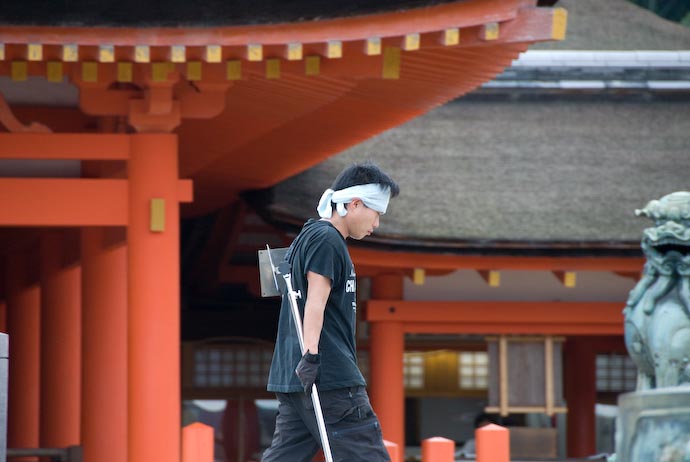
Nikon D200 + Nikkor 18-200mm f/3.5-5.6 VR @ 200mm — 1/125 sec, f/5.6, ISO 500 — map & image data — nearby photos
Hauling Stuff
while a dragon looks on
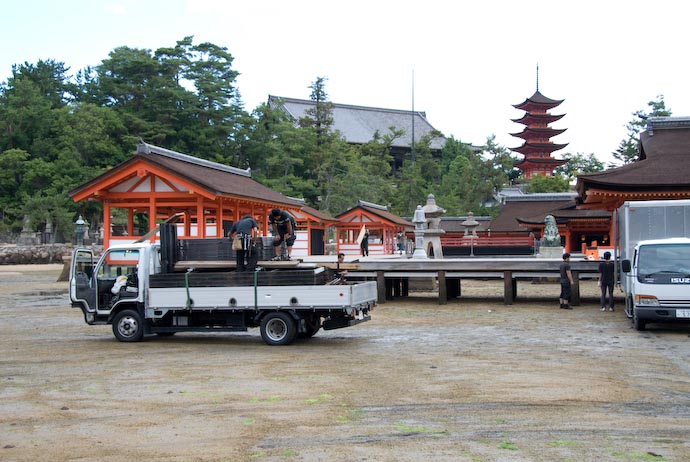
Nikon D200 + Nikkor 18-200mm f/3.5-5.6 VR @ 29mm — 1/400 sec, f/4.5, ISO 500 — map & image data — nearby photos
Packing Up
(view from the side)
They took the opportunity of low tide to drive out onto the intertidal zone to make the job easier.
A few pretty pictures....
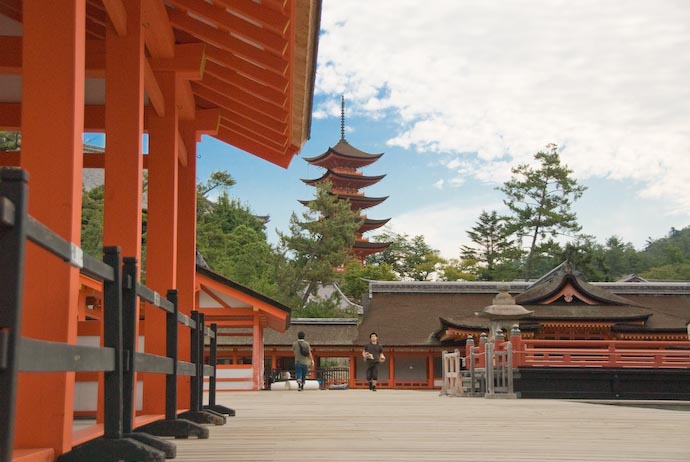
Nikon D200 + Nikkor 18-200mm f/3.5-5.6 VR @ 40mm — 1/1500 sec, f/4.5, ISO 320 — map & image data — nearby photos
Side View
(the dais is on the right; our seats were about where the guy facing away is standing)
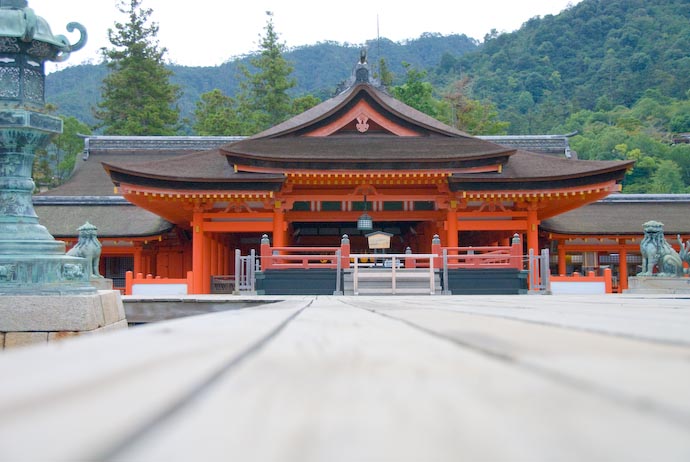
Nikon D200 + Nikkor 18-200mm f/3.5-5.6 VR @ 36mm — 1/500 sec, f/4.5, ISO 500 — map & image data — nearby photos
Front View Closeup
At the highest of high tides, the water comes right to the tops of these boards
Walking around the shrine to the back, you could see the little tent used as the room for the event staff and the artist before/after the concert, on a little patch that's always above water.

Nikon D200 + Nikkor 18-200mm f/3.5-5.6 VR @ 32mm — 1/500 sec, f/4.5, ISO 320 — map & image data — nearby photos
View from the Back
The big orange gate in the background is the main gate for the shrine, and is out in the middle of the water when the tide is in. It's brilliantly lit up at night, but was at our backs during the concert. The singer had a direct view during the whole concert, which he said he really enjoyed.
Of course, we really enjoyed it as well, both before and after the concert, and the next day. It looks small in the picture above, but dominates much of the area, and is the world famous symbol for Miyajima, one of the historically “three beautiful scenes” of Japan. I took a bazillion pictures of it that will be appearing on my blog shortly....
